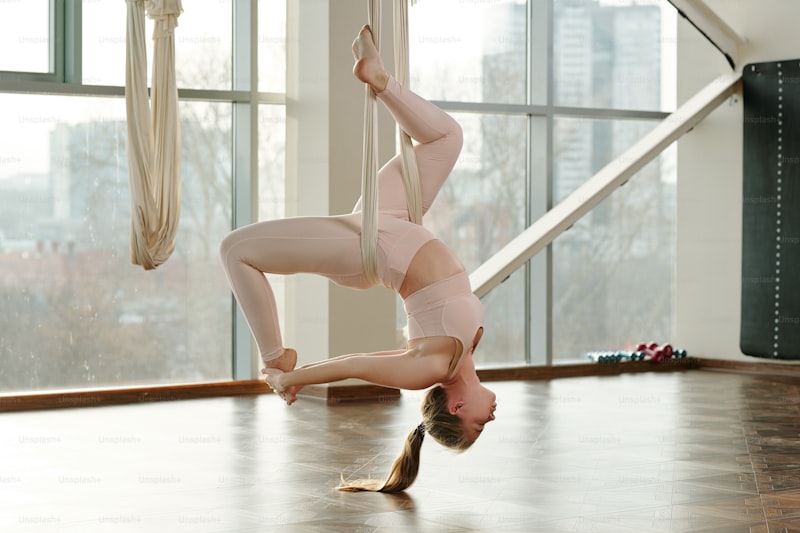What Is Antigravity Yoga?
Imagine a room with sumptuous silk hammocks draped from a high ceiling. In each hammock a yoga student is working through their yoga practice using the hammock to support parts or all of their body. Maybe the hammock is under the front thigh in Warrior, then under the back in Upward-facing Bow or under the hips to facilitate Downward Dog. Sometimes the whole body is supported in the hammock in Headstand, Inverted Lotus or Savasana. The practice is graceful and flowing, accompanied by music and more reminiscent of ballet than yoga.
Sounding familiar? Where have you seen this before? Maybe in an Olympic opening ceremony, possibly at that Cirque de Soleil performance you marvelled at or on Broadway…. What I have described is actually a recent evolution of yoga called Antigravity Yoga, an eclectic fusion of dance, tumbling, aerobatics and traditional Yoga all rolled into one physically challenging discipline
From Footloose to Flying Yoga
Antigravity Yoga is the brainchild of Christopher Harrison, the founder and director of Antigravity Inc. Originally from Chicago, aged 23 and a dance major at the University of Utah, his first break came when he was cast in the 1980’s film Footloose. During filming Kevin Bacon gave him some inspirational advice:
If you want to make it – go there and stay there and don’t give up – if you have talent you’ll find your way.
And so he moved to move to New York to follow a path in the entertainment industry.
By the early 90’s Christopher was a producer, director and choreographer with numerous high profile aerial performances. He developed the idea for his system while playing around in hammocks at an Ayurvedic Centre in India. Having also studied Yoga, Pilates, Kinesiology and Physiotherapy, he gradually incorporated hammocks into routine warm ups for performers and found far fewer of his dancers were getting injured. As he suffered from wrist injuries himself and therefore struggled with some traditional poses, he found using hammocks in his yoga routines to be hugely beneficial. And thus Antigravity Yoga was born. Since then, Harrison’s Antigravity Yoga, also known as Aerial Yoga or Flying Yoga, has been steadily gaining popularity worldwide with celebrities like Gwyneth Paltrow extolling its virtues and, if her figure is anything to go by, demonstrating its body sculpting potential.
Hammock or Mat?
Antigravity Yoga claims that hammocks allow students to relax into a deeper stretch than in traditional yoga. As the hammocks support some or all of a yogi’s body weight, finding correct alignment is also easier. Rhythmic movement is used to add a dynamic stretching element to the practice, which is in line with what’s commonly accepted as good practice in athletic warm ups.
Using a hammock to support the weight of the body in inverted postures reduces, and in some cases eliminates, compressive forces on the joints. Think of poses like Headstand, Downward-Facing Dog and Upward-Facing Dog. I know I could stay in these poses much longer if I had the help of a hammock! These inversions become much more accessible to anyone suffering from painful wrists, arthritic thumbs, tennis elbow or any other physical ailment.
Many back pain sufferers swear that hanging upside down significantly relieves their symptoms and Antigravity Yoga can do just that. Physiotherapists, osteopaths and chiropractors have used this principle to treat spinal conditions for generations. A Google search of sites advertising Antigravity, Aerial and Flying Yoga certainly brings up plenty of testimonials from students telling how their aerial practice has helped back and neck pain.
Using a hammock when practicing Antigravity Yoga makes advanced poses accessible to the less experienced student. It can even be beneficial to the advanced practitioner by allowing them to explore poses they have yet to experience. Hence it can be used by beginners, intermediates or advanced yogis to enhance their practice. In all cases it will develop core strength, particularly on transitions from one pose to another when fully supported by the hammock.
And last but not least, the unique opportunity to hang upside down with no pressure on the head or arms opens up the possibility of holding poses like Headstand, Plough and Shoulder Stand for much longer. There are many claims about the range of benefits from time spent inverted: more blood to the brain, slower breathing, more efficient breathing, improved lymphatic drainage, gives the heart a break, mood boosting, lower heart rate and lower blood pressure… the list is seemingly endless! Certainly claims for improved memory and the age-defying benefits of increased blood flow to the brain and face abound in adverts for this style of yoga.
But is it all good?
This style of yoga is not for everyone. Anyone with high or low blood pressure, glaucoma, or severe arthritis are advised against trying Antigravity Yoga. Students with poor balance, anyone who has a fear of falling or is suffering from conditions like Vertigo or Meniere’s disease that cause dizziness are likely to feel very uncomfortable using the hammocks. If you’re baking a bun in the oven, or you’ve recently had surgery, then Aerial Yoga may not be for you.
To Try Or Not To Try?
Antigravity Yoga can be a wonderful diversion from your regular class. If you’re experiencing some difficulty in a pose, perhaps this is a place where you could explore it more fully. Maybe your inner dancer is attracted by the music and elegance. Or maybe you simply like the idea of flying.
And to come back to where we started – is Antigravity Yoga actually yoga or acrobatics? Does it really matter? You’ll get stronger, increase your flexibility, find peace and stillness of the mind, which is exactly what yoga is, isn’t it? After all, a fully supported savasana in a soft silk cocoon is how I’d like to end my practice – it looks perfectly heavenly!












